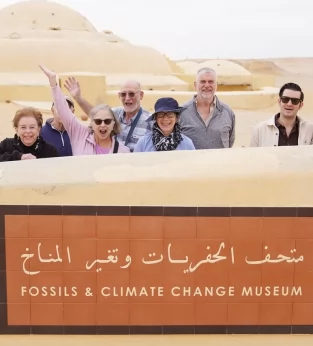Stay updated!
The Egyptian Museum on Tahrir Square in Cairo remains one of the world’s greatest repositories of ancient artifacts, even after the relocation of Tutankhamun’s treasures and the royal mummies to other museums. With around 150,000 exhibits, it offers an extraordinary journey through over 5,000 years of Egyptian history, and what visitors see is only a fraction of its full collection, as many pieces remain in the museum’s vast underground storerooms. Before entering, take note of the stone sarcophagus in the garden on the left, where Auguste Mariette (1821–1881), the museum’s founder and the first head of the Egyptian Antiquities Service, is buried. His efforts helped prevent countless artifacts from being taken abroad.
On the ground floor, the exhibits are arranged chronologically. The first room displays relics from Egypt’s earliest periods, including the remarkable Narmer Palette, which depicts the unification of Upper and Lower Egypt under Pharaoh Narmer around the 3rd millennium BC. Nearby halls showcase masterpieces from the Old Kingdom (28th–22nd centuries BC) such as the seated statue of Pharaoh Djoser, the wooden figure of the Lector Priest Ka-aper, and the lifelike statues of Rahotep and Nofret, all reflecting the exceptional skill of ancient Egyptian sculptors. One of the most famous wall paintings, the “Geese of Meidum”, over 4,000 years old, captivates visitors with its vivid colors and attention to natural detail.
In the Middle Kingdom gallery (22nd–18th centuries BC) stands the impressive statue of Montuhotep II (Nebhepetre), painted black to symbolize fertility and the god Osiris. The New Kingdom section features masterpieces such as the sphinx statue of Queen Hatshepsut, one of ancient Egypt’s most remarkable rulers. The Amarna Period hall, devoted to the reign of Akhenaten, reveals the radical changes he brought to Egyptian religion and art. Among the highlights is the exquisite quartz head of Nefertiti, believed to be a model for the world-famous bust in Berlin.
Even without the treasures of Tutankhamun, the Egyptian Museum continues to impress with its depth, diversity, and historic atmosphere. The elegant 19th-century building itself is a piece of history, a timeless witness to Egyptology’s beginnings. Visiting this museum remains an unforgettable cultural experience and an essential part of any journey through Egypt’s ancient past.
You can explore the Egyptian Museum on optional excursions organized by Inside Egypt, including the 14 Days in Egypt Tour, where participants have the chance to visit this iconic museum and admire some of the most important artifacts of ancient civilization in the heart of Cairo.
Make sure you get to visit this amazing museum with us at Inside Egypt. You’ll not regret it! Book your Egypt tour package!













